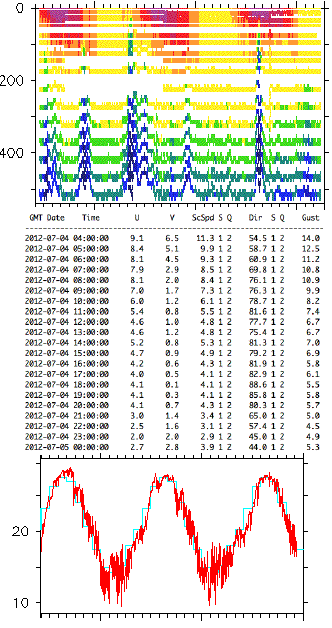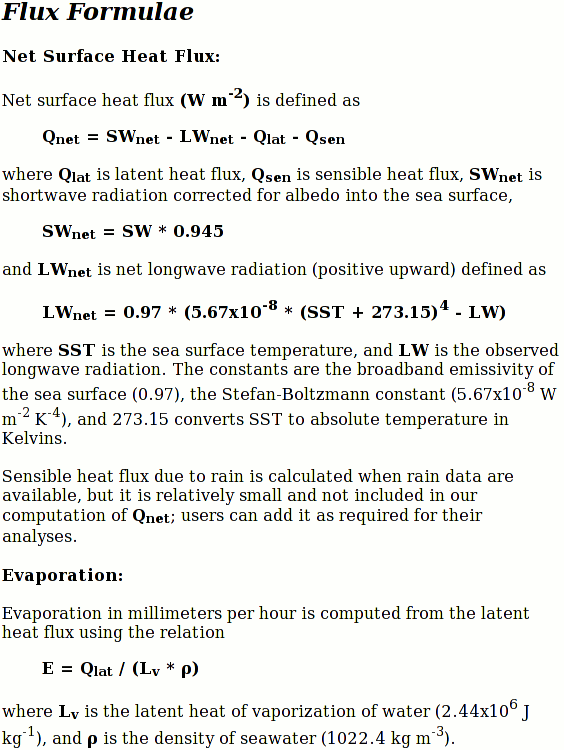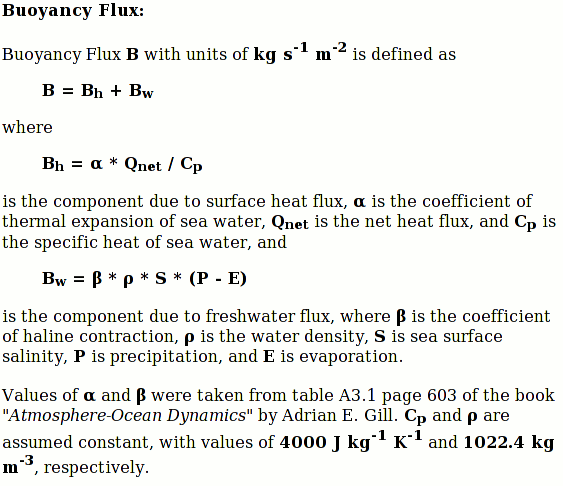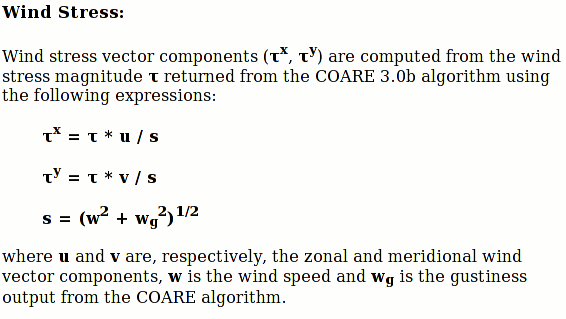 |
Algorithm for Surface Air-Sea Fluxes:
We used the COARE 3.0b algorithm to compute bulk air-sea fluxes,
including latent and sensible heat flux, net heat flux, and other
associated fluxes including evaporation, evaporation minus precipitation,
sensible heat flux due to rain, buoyancy flux,
and wind stresses.
The COARE 3.0b algorithm is detailed in
Fairall, C.W., E. F. Bradley, J. E. Hare, A. A. Grachev, and J. B. Edson,
2003: Bulk Parameterization of Air-Sea Fluxes: Updates and Verification
for the COARE Algorithm. J. Climate, 16, pp 571-591.
We downloaded the fortran version of the software from ftp://ftp.etl.noaa.gov/users/cfairall/bulkalg/cor3_0/.
Implementation of this algorithm at NOAA/PMEL was guided by
Cronin, M.F., C. Fairall, and M.J. McPhaden, 2006: An assessment of buoy
derived and numerical weather prediction surface heat fluxes in the
tropical Pacific. J. Geophys. Res., 111, C06038, doi:10.1029/2005JC003324.
|
|
|
Flux computation details
Hourly:
To compute hourly fluxes, we use hourly averages for all input
data, in addition to using the warm-layer and cool-skin corrections
which are built into the COARE 3.0b algorithm.
To provide the best possible estimates of the hourly surface
fluxes, generally speaking, we compute them only at times when there is a complete set of
input data. Fluxes are relatively insenstive to some inputs and in cases
where these are missing, we fill them in various ways so we can still
compute fluxes.
For sea level pressure we replace missing data with the long term mean
value for the buoy site computed from the entire record.
For near surface currents which are used to compute wind speed relative
to the sea surface, we replace missing values using the OSCAR surface
currents from JPL. The OSCAR data have 1/3 degree spatial recolution,
and are detailed at http://podaac-ftp.jpl.nasa.gov/dataset/OSCAR_L4_OC_third-deg.
When in-situ current observations shallower than 36 meters are not
available, we use OSCAR surface currents from JPL intstead, interpolated
to the buoy location and data time.
Net shortwave radiation is computed using an albedo climatology
obtained from the Interantional Satellite Cloud Climate Project at
http://isccp.giss.nasa.gov/products/browsesurf1.html. The climatology
is interpolated in space and time to the particular OCS mooring location
and data time.
If longwave radiation data are missing, they are filled using a
parameterization from Clark et al (Clark, N.E., L. Eber, R.M. Laurs,
J.A. Renner, and J.F.T. Saur Heat Exchange Between Ocean and Atmosphere in the Eastern
North Pacific for 1961-1971, NOAA Tech. Rep. NMFS SSRF-682, U.S.
Dept. of Commerc., Washington, D.C., 1974). This parameterization
requires an input cloudiness value, and this is computed using
another parameterization developed at PMEL. Note that the longwave
data available for display and download do not have missing values
filled in the way described above. The filling is only done for the
purposes of doing the warm layer and cool skin corrections in the COARE
bulk algorith.
Rain rate data are corrected for wind speed, using the method of Serra et al
(Serra, Y.L., P.A'Hearn, H.P. Freitag, and M.J. McPhaden, 2001: ATLAS self-siphoning
rain gauge error estimates. J. Atmos. Ocean. Tech., 18, 1989-2002).
When rain data are missing, the COARE bulk algorithm is still called
using an input rain rate of zero. This allows us to compute wind stress
and latent and sensible heat fluxes, but in such cases, computed values
which are dependent on rain rate, e.g., the sensible heat flux due to
rain and evaporation-precipitation are set to the missing value after
the bulk algorithm is called.
Daily:
Daily fluxes are computed by averaging the hourly fluxes to daily resolution.
5-Day, Monthly, and Quarterly Averages:
5-Day, monthly, and quarterly averages of surface fluxes are computed
from daily fluxes.
Climatologies for Surface Fluxes:
The surface heat flux climatologies, which are shown in time series
displays as blue lines are based on the monthly
Objectively Analyzed Air-Sea
Fluxes (OAFlux) from Woods Hole Oceanographic Institution. These include
latent and sensible heat fluxes, evaporation, net shortwave and
longwave radiation, and net heat flux. The climatology for
E-P was computed by subtracing the Xie and Arkin rain
climatology (1997) from the OAFlux evaporation
|
|
|











